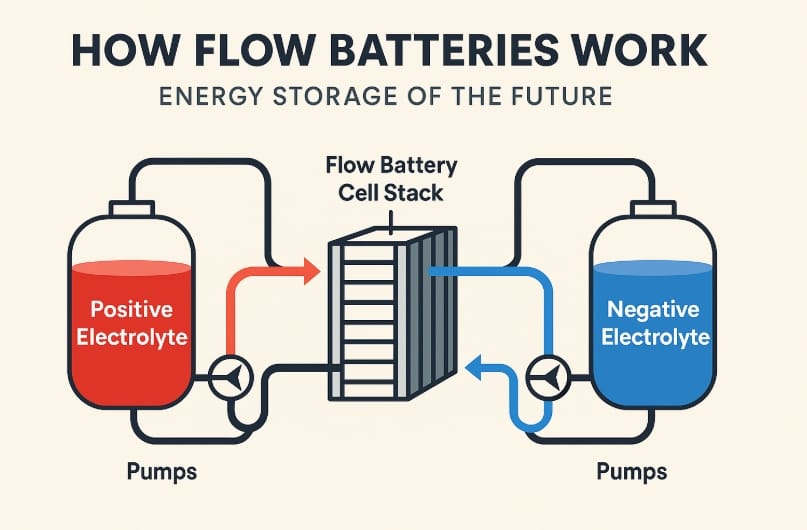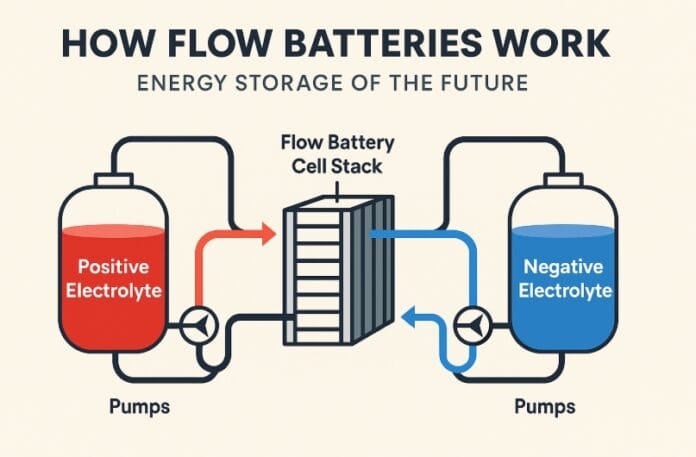Flow Battery: As solar and wind power become more popular, one big question keeps coming up: How do we store all that clean energy when the sun isn’t shining or the wind isn’t blowing?
That’s where a flow battery comes in.
This special type of battery isn’t like the lithium-ion ones in your phone or electric car. Instead, it’s designed to store large amounts of energy for long periods—perfect for solar farms, wind power stations, and even backup power for homes or businesses.
In this post, we’ll walk you through what a flow battery is, how it works, and why it could be the future of energy storage.
🔋 What Exactly is a Flow Battery?
A flow battery is a kind of rechargeable battery that stores energy in liquid form. Unlike regular batteries, where everything is packed inside a single unit, flow batteries keep their energy in two large tanks filled with special liquids.
Here’s the basic idea:
- You have two tanks filled with liquid electrolytes (one positive, one negative).
- These liquids flow into a device called a cell stack.
- Inside the cell stack, a chemical reaction takes place, producing electricity.
When you want to store energy again, the whole process runs in reverse.
It’s a little like fuel cells—but instead of burning fuel, you’re just cycling liquids in and out to store or release energy.
🧪 How Do Flow Batteries Work in Simple Terms?
Think of a flow battery like a water-powered energy system:

- You have two tanks of colored water (representing two different liquids).
- You pump that water through a filter system (the cell stack).
- Inside that filter, the water reacts, and electricity is made.
- The used water goes back to the tanks, ready for the next cycle.
The special liquids—called electrolytes—carry charged particles. When pumped into the battery system, these particles swap electrons, and that creates power.
Need more energy? Just use bigger tanks with more liquid.
⚙️ Types of Flow Batteries (with Simple Examples)
There are a few different types of flow batteries, based on the chemicals they use. Let’s break down the most common ones:
1. Vanadium Redox Flow Battery (VRFB)
- The most popular type in the market today.
- Uses vanadium in both tanks—but in different forms.
- Super stable and long-lasting (can work for 20 years or more).
- Doesn’t suffer from liquid mixing problems.
Best for: solar and wind farms, long-term energy storage.
2. Zinc-Bromine Flow Battery
- Zinc is stored on a plate when charged, and bromine flows in liquid form.
- Has a higher energy capacity than some others.
- Needs a little more maintenance to clean off the zinc buildup.
Best for: backup systems, off-grid homes, industrial storage.
3. Iron-Chromium Flow Battery
- One of the cheapest in terms of raw materials.
- Not as efficient yet, but research is improving this type quickly.
Best for: budget-friendly, large-scale projects.
4. Organic Flow Battery
- Uses carbon-based materials (sometimes from plants or waste).
- Still under development but could be very eco-friendly and affordable in the future.
Best for: sustainable, green tech fans—watch this space!
🔄 Flow Battery vs Lithium-Ion: What’s the Real Difference?
Let’s compare flow batteries to the lithium-ion batteries you’ve probably heard of:
| Feature | Flow Battery | Lithium-Ion Battery |
|---|---|---|
| Lifespan | 10,000–20,000 cycles (20+ years) | 3,000–5,000 cycles (5–10 years) |
| Storage Duration | 8 to 12 hours (or more) | 1 to 4 hours max |
| Scalability | Easy—just add bigger tanks | Harder to scale |
| Fire Risk | Very low (non-flammable liquids) | Higher (can overheat/catch fire) |
| Cost (2025 est.) | ~$300–500/kWh (falling fast) | ~$150–300/kWh |
| Energy Density | Lower (bulkier) | Higher (compact size) |
✅ Why Flow Batteries Are a Smart Choice
Let’s look at some real-world reasons why people love flow batteries:
1. They Last for Decades
Because the liquids don’t wear out like other battery materials, flow batteries can keep running for more than 20 years with minimal performance drop.
2. Super Safe to Use
There’s no fire hazard, no overheating, and no toxic fumes. Great for homes, factories, and places with strict safety standards.
3. Easy to Expand
If you need more power, add more stacks. If you need more storage, just use bigger tanks. It’s modular, like building blocks.
4. Deep Discharge Without Damage
Most batteries degrade if you use 100% of the energy. Not flow batteries. You can fully drain and recharge them without worry.
5. Work in Hot and Cold Weather
Flow batteries can handle a wider range of temperatures, making them perfect for remote locations and off-grid living.
⚠️ Things to Consider Before Choosing Flow Batteries
Flow batteries aren’t perfect. Here are a few things to keep in mind:
1. Bigger and Bulkier
Because they use large tanks, they take up more space than lithium batteries. They’re not meant for cars or portable gadgets.
2. Higher Setup Cost
Even though they last longer, they’re more expensive upfront. But the cost evens out over time thanks to low maintenance and long life.
3. Regular Maintenance
The pumps and parts need cleaning, especially with certain chemistries like zinc-bromine.
4. Still Growing Market
They’re not as widely available as lithium systems—yet. But with increasing demand, more companies are jumping in.
🏠 Where Are Flow Batteries Used Today?
Here’s where flow batteries are making a real difference:
🌞 Solar and Wind Energy Storage
They’re perfect for storing extra energy during the day and releasing it at night or on cloudy days.
🏙️ Grid Backup and Support
Power companies use them to help balance energy supply and demand, avoid blackouts, and stabilize the grid.
🌴 Remote and Off-Grid Areas
From tropical islands to rural farms, flow batteries provide reliable power without fuel.
🏭 Businesses and Industry
Companies use them to save money by storing energy when prices are low and using it when rates are high.
📉 What Do Flow Batteries Cost in 2025?
- Today’s average cost: $300 to $500 per kilowatt-hour
- Expected to fall below $200/kWh by 2030
- Lifecycle cost is often cheaper than lithium over time
- Big companies like Invinity, ESS Inc., and Redflow are leading the market
🌍 Are Flow Batteries Good for the Environment?
Yes—very.
- No toxic metals like cobalt or lead
- Reusable liquids that can last for thousands of cycles
- Easier to recycle or repurpose than lithium
- Some types even use organic materials
They’re an excellent match for clean energy goals.
🔮 The Future of Flow Batteries
Experts believe flow batteries will soon be a major part of how we store solar and wind energy—especially in systems that need 8 to 12 hours of backup or more.
As the technology improves and prices drop, they’ll be used in:
- Smart cities
- Renewable energy farms
- Large homes and buildings
- National power grids
If you want to future-proof your energy setup, it might be worth looking into flow battery systems now.
🧠 Final Thoughts: Should You Consider a Flow Battery?
If you’re serious about clean energy, long-term savings, and energy independence, a flow battery could be a smart move.
They’re not right for every situation (like tight spaces or mobile use), but for solar-powered homes, farms, factories, or entire communities, they’re a game-changer.




